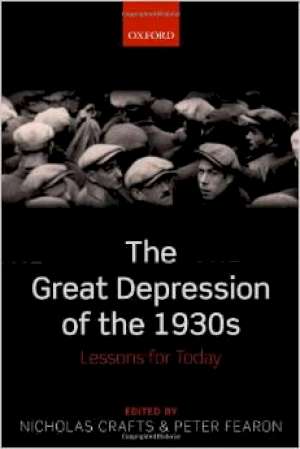16 January 2015
The Great Depression of the 1930s
Lessons for today
Nicholas Crafts and Peter Fearon (eds)
2013, Oxford University Press, 480 pages, £68.00
ISBN 9780199663187
Reviewer: Bill Allen

The analogy between the recent financial crisis and the financial crisis that led to the Great Depression of the 1930s is both seductive and compelling. This is a collection of fourteen papers on that theme – too many to do justice to in a short review. It begins with two papers by the editors that provide an admirable summary of what happened in the 1930s, a brief comparison with recent events, and what the lessons are. In doing so, they also summarise the literature on the subject, including the other papers in the collection.
In sum, they conclude that the collapse in American economic activity in the early 1930s was caused by large shocks to aggregate demand, a fragile financial system, an inadequate fiscal response, and bad monetary policy. In other countries, attempts to stay on the gold standard in a deflationary world economic environment proved damaging and futile. The banking crises in Austria, Hungary and Germany did massive damage. The book explores the disintegration of the international economy, the behaviour of labour markets (Timothy Hatton and Mark Thomas conclude that union militancy aggravated U.K. unemployment during the Depression), the frenzy of financial regulation that followed the bank failures of the early 1930s in the United States, and the problems of emerging from recession.
In the 1930s, the sooner countries abandoned the gold standard, the sooner they recovered. Monetary policy was decisive. In the United States, monetary growth accelerated after gold was abandoned in 1933, and there was a large reduction in real interest rates as inflationary expectations increased. In Britain, the cheap money policy adopted in 1932 led to a house-building boom. In Germany, as Albrecht Ritschl shows, monetary expansion after 1931 took place behind a protective barrier of exchange controls.
Fiscal policy was not used consciously, or in some cases at all, to support recovery: Price Fishback’s paper shows that the U.S. federal budget went heavily into deficit in 1930- 32, but only because tax revenues collapsed along with the economy; President Hoover wanted to maintain a balanced budget. And Roger Middleton demonstrates the power of orthodox doctrine in inhibiting fiscal expansion and neutralising automatic stabilisers in Britain. Ritschl suggests that variations in fiscal policy had little effect on the German economy.
There certainly have been lessons for today, which have been applied, above all by Ben Bernanke, the historian of the Great Depression and the Chairman of the Federal Reserve, whose prompt, decisive and effective actions have spared the world at large the horrors of the 1930s. Yet, as Nikolaus Wolf, Barry Eichengreen and Peter Temin point out, the situation in the euro area is alarming. The monetary regime of the euro area is very like that of the gold standard. However, the euro is also a manifestation of a union established to prevent there being any more wars in western Europe and whose avowed purpose is ‘ever closer union’ among the peoples of Europe. The member countries therefore feel under great pressure to remain members, which means being subject to its monetary and fiscal disciplines. Indeed, there is no legal route to withdrawal.
The result has been to put some countries back into the position of gold standard countries in the early 1930s. They cannot control their monetary policy, which is directed at achieving domestic deflation; they are obliged to pursue fiscal consolidation; and their banks are in a fragile condition, partly because they are stuffed with securities issued by domestic governments whose financial condition is insecure. It is not surprising that unemployment and emigration are high. Moreover, there is no detailed consensus about how far their financial problems should be regarded as common problems of the euro area (or the European Union) and how far they should be left to national governments to sort out somehow. The participants are making up the rules as they go along, under pressure from their national electorates on one side and events on the other. This is a very dangerous procedure and there can be no certainty of a happy ending.
The fourteen papers are distinguished by their intrinsic interest, their high factual content, and their relevance to recent and current developments. One of the lessons of recent events is that economic history is more important than most people thought, and this book is highly recommended to anyone interested in recent economic events and their antecedents.
